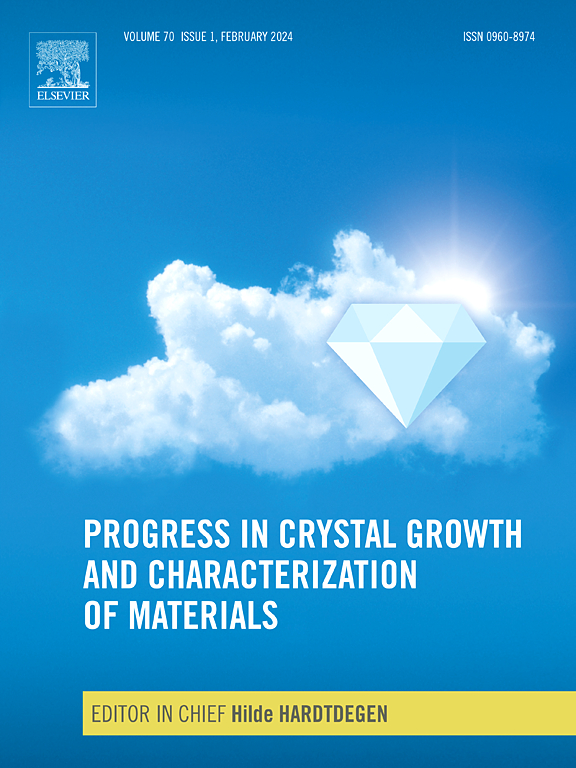The growth of titanium doped sapphire for laser application
IF 1.9
2区 材料科学
Q1 CRYSTALLOGRAPHY
Progress in Crystal Growth and Characterization of Materials
Pub Date : 2025-04-17
DOI:10.1016/j.pcrysgrow.2025.100666
引用次数: 0
Abstract
The main application of Ti doped sapphire (Ti:sapphire) lies in the field of lasers, thanks to its outstanding production of ultra-short pulses due to the presence of doping Ti3+ ions. The absorption and emission mechanisms of this crystal are intricate, necessitating consideration of point defects existing in the grown crystal. A plethora of liquid-phase growth methods yield crystals of diverse sizes and quality. This paper gives a comprehensive review of the literature on managing dopants during the growth of Ti doped bulk sapphire crystals.
Substantial research has indicated that the presence of detrimental Ti4+ ions diminishes the crystal laser efficiency due to their residual absorption. Although annealing under reducing atmosphere is an efficient way to increase the Ti3+/Ti4+ ratio, this process becomes increasingly time-consuming as the demand for larger optical components increases. Consequently, it would be more practical and convenient to control this ratio directly during the growth processes. However, the conversion mechanisms between the two Ti ions valences during crystal growth and annealing remain largely unexplored.
A study of the thermodynamics of the Al2O3/TiO2 and Al2O3/Ti2O3 solid and liquid solutions as a function of the partial pressure () and oxygen activity is crucial for understanding these mechanisms. This paper presents corrected, reliable phase diagrams that enable quantitative prediction of the effect of on the melt concentrations of the two ions. Consequently, a novel value of the absorption coefficient constant, pertinent to Ti4+ concentration measurement, is proposed. Equilibrium with the solid solution yields segregation coefficients that appear distinct for the two ions. Given their influence on oxygen activity during growth, the effect of surrounding furnace parts, such as graphite casing or Mo crucible, is also important.
Understanding the behavior of Ti3+and Ti4+ ions in the grown crystal as a function of pulling time and considering the levels in the furnace atmosphere, requires the knowledge of solid-state electrochemistry, including the charge carriers and the Al and O vacancies. This foundation allows the development of a physico-chemical model illustrating the evolution of ion valence during growth. Analysis of experimental results from existing literature gives the necessary diffusion coefficients and reaction rate constants. Investigating crystal-atmosphere interaction provides the required boundary condition for solving the problem. The findings exhibit qualitative agreement with experimental measurements of Ti3+ and Ti4+ concentrations in grown Ti:sapphire crystals.
激光用掺钛蓝宝石的生长
掺钛蓝宝石(Ti:sapphire)的主要应用是在激光领域,由于掺杂Ti3+离子的存在,可以产生出色的超短脉冲。该晶体的吸收和发射机制复杂,需要考虑生长晶体中存在的点缺陷。过多的液相生长方法产生不同大小和质量的晶体。本文综述了国内外有关掺杂钛块状蓝宝石晶体生长过程中掺杂物管理的文献。大量研究表明,有害的Ti4+离子的存在由于其残余吸收而降低了晶体激光效率。虽然在还原气氛下退火是提高Ti3+/Ti4+比的有效方法,但随着对大型光学元件需求的增加,该过程变得越来越耗时。因此,在生长过程中直接控制这一比例将更加实用和方便。然而,在晶体生长和退火过程中,两种Ti离子之间的转换机制仍未得到充分的研究。研究Al2O3/TiO2和Al2O3/Ti2O3固液溶液的热力学与分压(pO2)和氧活度的关系对于理解这些机理至关重要。本文提出了修正的、可靠的相图,可以定量预测pO2对两种离子熔体浓度的影响。因此,提出了一个新的吸收系数常数值,适用于Ti4+浓度的测量。与固溶体的平衡产生两种离子明显不同的偏析系数。考虑到它们在生长过程中对氧活性的影响,周围的炉子部件(如石墨外壳或钼坩埚)的影响也很重要。了解Ti3+和Ti4+离子在生长晶体中的行为作为拉动时间的函数,并考虑到炉内气氛中的pO2水平,需要固态电化学的知识,包括电荷载流子和Al和O空位。这个基础允许发展一个物理化学模型,说明在生长过程中离子价的演变。对已有文献的实验结果进行分析,给出了必要的扩散系数和反应速率常数。研究晶体-大气相互作用为解决这一问题提供了必要的边界条件。这些发现与实验测量的钛蓝宝石晶体中Ti3+和Ti4+浓度在定性上一致。
本文章由计算机程序翻译,如有差异,请以英文原文为准。
求助全文
约1分钟内获得全文
求助全文
来源期刊

Progress in Crystal Growth and Characterization of Materials
工程技术-材料科学:表征与测试
CiteScore
8.80
自引率
2.00%
发文量
10
审稿时长
1 day
期刊介绍:
Materials especially crystalline materials provide the foundation of our modern technologically driven world. The domination of materials is achieved through detailed scientific research.
Advances in the techniques of growing and assessing ever more perfect crystals of a wide range of materials lie at the roots of much of today''s advanced technology. The evolution and development of crystalline materials involves research by dedicated scientists in academia as well as industry involving a broad field of disciplines including biology, chemistry, physics, material sciences and engineering. Crucially important applications in information technology, photonics, energy storage and harvesting, environmental protection, medicine and food production require a deep understanding of and control of crystal growth. This can involve suitable growth methods and material characterization from the bulk down to the nano-scale.
 求助内容:
求助内容: 应助结果提醒方式:
应助结果提醒方式:


